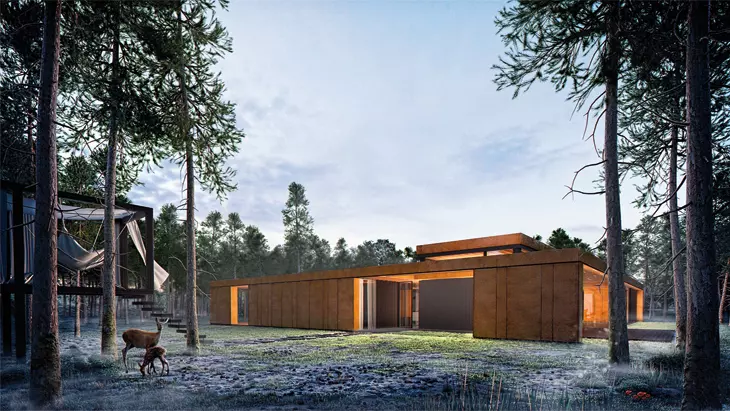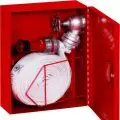The investor's biggest dream was to live in a forest setting. Designers from P3 architectural studio tried to meet the high expectations, designing Corten house. The house was located in the midst of the forest, trying to correlate with the surroundings.
The project involves placing the house surrounded by nature
© P3 Studio
residence on the edge of the forest
The house was located in a clearing in the middle of the forest. For the client, the priority was to escape from the hustle and bustle of the city to a place close to nature, allowing you to enjoy it at your fingertips. The environment is created by nature in the form of meadows and forests.
One of the investor's recommendations to the architects was to create large glazing that would allow continuous viewing of wild nature. The interaction of the house with the natural surroundings became a priority aspect during the design phase. The large glazing allowed the boundary between the interior of the house and the surrounding nature to blur.
A small stream flows through the atrium
© Pracownia P3
functionality
The house was composed of four zones, differing in functionality, which surround the atrium. A living zone was placed on the west side, consisting of a living room, kitchen and dining room. A garage was located next to it. The living zone was placed here because of the opening to the clearing and the forest. Orientation to the southwest allows to provide a large amount of daily light, and additional arcades provide an optimal influx of light in winter and limit it in summer.
Functional zones were designed according to needs and placed in four different parts
© Pracownia P3
Theprivate zone, consisting of a bedroom combined with a dressing room, a bathroom with a sauna, was placed on the east side. The choice of location for the bedroom on this side was influenced primarily by the possibility of watching the sunrise and opening the view to a small grove. In the northern part a space for guests was located.
Thecenter of the establishment is an atrium with a fireplace, which connects all zones of the house. A unique solution is the stream of water that flows through the atrium, cooling the air on hot days. An important solution in the house are partitions that extend from the walls, which allow to separate functional zones.
technology and material
For the investors and architects of P3 Architectural Studio, it was important to use natural materials. The building was designed using a timber frame construction system. The name of the house is also not accidental. The facade of the building made of corten sheet creates a rusted effect, while correlating with the surroundings.
house plan
© Pracownia P3
The arcades and glazing have been designed to optimize heat gain and loss, during different seasons, taking into account the directions of the world and exposure to sunlight. The ventilation system with under-floor ducts is also unique, optimizing the need for heat in winter and cooling in summer.
Architect Radoslaw Poplawski of Pracownia P3 talks about the creation of the project.
Wiktor Bochenek: Where did the idea to use corten come from?
Radoslaw Poplawski: One of the main ideas when designing the house was that it should correlate with the surroundings and disappear against the background of the surrounding forest. A wood facade was also considered, but the choice was determined by the practical aspects of "maintenance-free" corten. The rusted facade fits perfectly into the color range of the surrounding greenery.
Wiktor Bochenek: What did the investors require above all?
Radoslaw Poplawski: I'll quote from the investor here: "I always wanted to live in a forest environment. Instead of walls, to have large glazing to constantly look at the surrounding nature."
Spending time in the house, in its rooms, each time we experience a different landscape outside the window. The living room offers a picturesque view of a flowery clearing with a wall of forest in the background. From the huge window in the bedroom we see a pine grove. Relaxing in the small home spa, we commune with the greenery growing in the central atrium.
It was important to blur the boundary between inside and outside. By extending the glass barriers, the impression was that the surrounding nature is in symbiosis with the space of the house, that we are communing with nature.
The designed glazing, including arcades, is the result of a thorough analysis of the sunlight, in order to optimally manage the energy management of the house, without compromising the view through the windows.
An additional guideline of the investor was to use the building material available in the region. In view of the above, the building was constructed in a timber frame system, using wood from local sawmills.
axonometric projection
© Pracownia P3
Wiktor Bochenek: On what principle do the partitions in the house work?
Radoslaw Poplawski: The modeling of space in the house is based on a system of sliding walls "hidden" in the main structural walls. The system consists of both glass partitions, e.g. atrium opening, and solid walls cutting off individual zones of the house, i.e. private, guest or living areas.
Wiktor Bochenek: How was a flowing stream adapted to the building?
Radoslaw Poplawski: We took advantage of the high level of ground water to create a microclimate in the green atrium in the center of the house. In the summer, a flowing stream running through low cascades creates a refreshing climate. By opening the interior glazing, the air from the atrium cools the zones of the house from the inside.
In order for the system to work, it was necessary to build a forced-flow water system through the atrium, connected by a circuit to a pond located outside the house.
The corten steel is the defining element of the building
© Pracownia P3
Wiktor Bochenek: What was the most difficult, and what are you most satisfied with?
Radoslaw Poplawski: Contrary to appearances, the most difficult was designing a residence in an environment that imposed no restrictions! The freedom and complete freedom in the design, sometimes gave doubt to the issues of the decisions made.
We are most pleased that it was possible to perfectly interpret and read the investor's expectations. To propose solutions that fit into the image of the dream house, from aesthetic, to functional, to technical and implementation.
Fantastic cooperation of all parties of the investment process, made it possible to fulfill the dream of a house tailored to the investor's expectations, at the same time giving the architect satisfaction with the final project - a unique house.
Wiktor Bochenek: Thank you for the interview!
Corten House tries to correlate with the environment
© P3 Studio




































